Well, this was rather unexpected, we’d say. Under usual circumstances, a ‘support’ shoe is more firmer than a neutral shoe. Saucony Ride 7 more so than the Guide 8, Nike Structure 18 to the Pegasus 31, and so follows the assumed order of things.
Except that Mizuno Inspire 11 isn’t of that mold. While it is differentiated in a few ways, cushioning is softer than the Wave Rider 18. It is a lighter shoe too. Maybe that is what one of our readers meant when he said Mizuno was confusing. And just how much is the extent of functional separation from the Rider 18?
We’ll show and tell as we usually do, but after we tackle some of the smaller details. The reason why we’re referencing the Rider 18 is that we haven’t got any experience with the Inspire 9 or 10. If you’d like to share some thoughts on the previous models, the comment section is just the place to do that.
The Japanese brand’s ‘one-upper-many-midsoles’ cookie cutter approach is applied on the Inspire 11’s design, and thus you are greeted with a silhouette which looks strikingly familiar.
A stitched-on synthetic leather toe-cap right at the tip, joined to an overlay-free mesh forefoot. Molded Runbird logos, now seen umpteen times on other Mizuno models, is part of Inspire’s landscape too.
Other parts of sameness appear on the Inspire. There’s that leather eye-stay with punched-in eyelets, two-toned lacing of a somewhat twisty nature, and the padded wide tongue with a soft lining.
As was the case on Rider 18, you’re unlikely to experience much tongue slide on the Inspire. The extra width around the top keeps the un-gusseted tongue from sliding into available space on either sides.
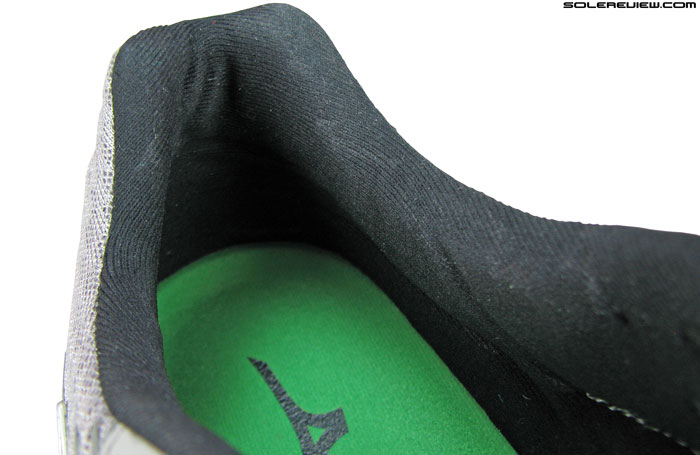
The Inspire 11 gets its collar padding rationed, no different from Rider 18, Creation 16 or Sayonara
Bereft of much padding, a malnourished collar area wraps around the ankle in the heel area, and comes flanked on the outside with the metallic label and circular patch. Despite that, grip isn’t bad, and we did not experience any heel slippage during our wear-tests.
These are parts from Mizuno’s standardised design template for the year 2014-15, and come in exact shape and texture as seen on recent shoes. The metallic patch (first picture of the review) says Wave Inspire in English and Japanese Katakana script, and yet again, reflectivity is reduced to the size of the heel Runbird logo.

Fit is spacious, meaning space ahead of toes and relaxed sides. You might be ok with buying a half size smaller.
Fit is similar to a shoe like the Wave Rider 18 or Sayonara 2, except for a key difference which we’ll shed light on after a few paragraphs. Roomy is the forefoot, runs nearly half size larger (you might need to go half down on Inspire) with ample ventilation coming from the unlined spacer mesh. Top down lacing pressure is kept at bay with the padded tongue, and the removable insole is a top job as usual. Comes equipped with the soft fabric lining used in other models as well, with blown foam as a cushioned base.
Inspire’s upper design would have been identical to the Wave Rider 18, except for the midfoot. It features the theatrical sounding ‘Dynamotion’ layer, which means different elements depending on whether you’re looking at the lateral or medial side.
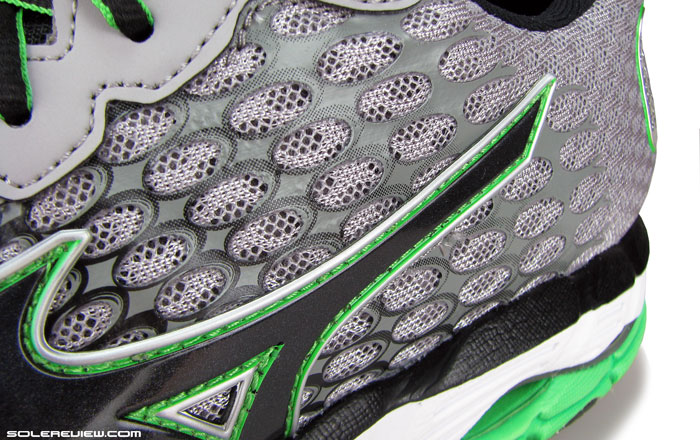
This is what Mizuno calls the ‘Dynamotion’. Happens to be a layer of perforated TPU heat fused on the upper.
On the lateral face of Inspire 11, a layer of perforated hot melt is fused on to the midfoot. This is meant to make the midfoot fit snugger, and looks like a hotrod flame graphic with its graduating dark-to-light colors. Or fish scale, depending on what you want it to look like. The medial treatment of Dynamotion is in form of synthetic leather fingers connecting the midsole base and lacing.
Does it work? While the panels make the upper look visually more compact, its effect on actual fit isn’t substantial. That said, the Inspire 11 does feel snugger, and not entirely so because of Dynamotion. You see, most of Inspire 11’s key elements of differentiation ( because of it being a support shoe) lies packed within its sole unit. One of them happens to be a wider midsole/outsole footprint. For comparison’s sake, let’s take the Wave Rider 18, where the sole unit has a narrower profile. The Inspire has a approximately 5 mm wider periphery compared to Rider 18.
Now assume that the upper fit was unchanged (from Rider 18) along with the increased midsole area. This would have created much more room than the Rider 18, and made the upper absolutely floppy. To counter this, Mizuno has made the upper shallower so that it adjusts to the larger footprint of Inspire 11.
However, horizontal width and vertical height are two different things when it comes to footwear, because actual foot height stays unchanged. This has the upper draping shallower over the foot, and hence making the fit snugger. So in plainspeak, the Inspire 11 and Wave Rider 18 are built on two different lasts. The insole markings also state likewise, with a M123 marking on Rider 18 and M124 on Inspire 11. There is more at work here than just the Dynamotion panel.
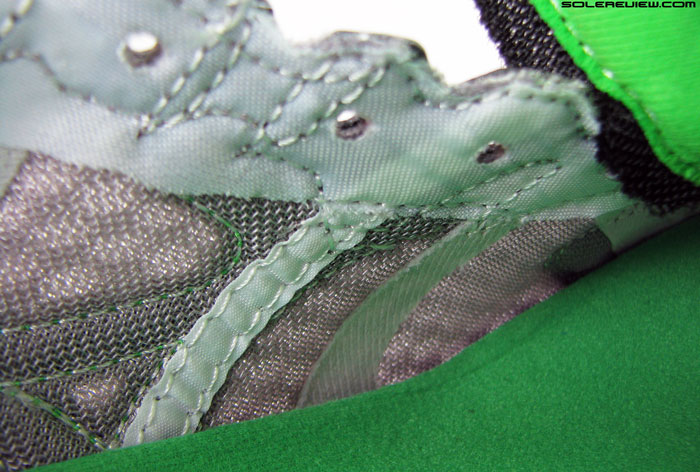
The white seam running across the arch center is an irritant. Not when worn with cushioned socks, but when used with thin socks or barefoot.
The problem with blanket standardisation of upper design is that good and bad both get washed up with the tide. Good in this case would be the roomy fit, anti-slide padded tongue and breathability. Bad is the internal seam, which is a one way ticket to foot chafing. Since the Inspire 11 is snugger, the seam makes its presence felt even more so. Wear thin socks, and the mild sensation of the rough edges passes through. Barefoot? Thank you very much. The current crop of Mizunos’ need to worn with thick socks so as to insulate the bare skin against this offending interior seam.
Except for this blemish, we find the fit of Mizuno uppers quite agreeable. There is plenty of room for splay, and the materials are nice, never mind every shoe visits the same convenience store for material shopping.
That was the upper. What goes on in the lower realms?
Apart from a wider midsole base – approximately 5 mm more than Wave Rider 18 – there are four more things which make the Inspire 11 the shoe it is. We will address these in numeric order.
1) This being a support or motion control shoe, the geometry of the Wave plate is designed differently, and specific to Wave Inspire 11. A typical Wave plate is corrugated on either sides, rising up and down in curves as it goes from back to front. This design is meant to better absorb impact forces during footstrike – though more for heel strikers than anyone else.
If it is a neutral shoe like the Rider 18 or Sayonara, the Wave curves on either sides will be on the near-same level. However, the Inspire being a motion control shoe, the Wave design on medial side (image above) is aggressively pointy. Compared to the gentler lateral (outer) side, the peaks of the plastic Wave rise sharply upwards. This has the obviously intent of controlling the deformation of the Wave plate on the medial side, and hence making the lateral Wave easier to compress. That makes the Inspire 11 a motion control shoe, doesn’t it?
And it is functionally effective too, to some extent. The Inspire 11 is at best, a mild motion control running shoe. It does have a bit of a lateral lean, but really, just a little more than a Rider 18 – which by the way has some degree of motion control too. The pointy ends of medial Wave seems as if they will poke into the foot, but they don’t.
2) This might come as a surprise to you, but the midsole foam used in Inspire is actually much softer than both the Rider 18 and Sayonara. The Inspire 11’s midsole has two foam layers, the white part forming the majority of it, and the green foam used as a lining between the heel Wave plate and outsole.
Both these are noticeably softer than what we have experienced in either the Rider 18, Sayonara 2, and even the Creation 16. Haven’t tested the Paradox or Hitogami yet, so as far as we’re concerned, the jury’s out on that.
3) Look at the Rider 18’s Wave unit from the side (or Sayonara 2 for that matter), and you’ll notice a hollow space around the curves, meaning you can see the other side. Not so in the Inspire 11.
There is some open area till the center, and then the soft, green foam fills in. Here, we flashed a torch (image below) into the Wave unit, and the foam part is clearly visible in the center.
With more lower density foam filling the crevices around the Wave unit, rear-foot landings feel cushioned, with the weight loaded on the soft heel core. It is certainly more cushioned than the Wave Rider 18 and Sayonara 2, and feels responsive too.
Softer foam means easier access to Wave’s deforming properties, so the Inspire’s ride combines cushioning and responsiveness in equal measure.
It is quieter too. The X-10 outsole used might still be hard, but a softer base allows the outsole pods to piston inwards, making landings less jarring. The heel crash pad also becomes more effective, as the soft foam extends its range of motion.
And then there’s the forefoot, which we’ll talk in the breakout below.
4) The forefoot blown rubber is thinner (than say Rider 18), which makes the front feel softer during transition. We also think that the rubber used is softer as well, though can’t be absolutely sure without using a durometer gauge. It could just be because of the thinner sheet.
Flexibility is good for a Mizuno, and bending happens ahead of the ball of the foot – as opposed to early stage flexing of Rider 18. The rubber grips well, and durability’s good too – although better in the heel than front.
The Inspire 11 is a light shoe. It comes in at 287 grams or 10 ounces, which is lower than Rider 18. It is not hard to see why. Despite the addition of Dynamotion upper welds, the foam is lower density, and there’s some weight saving off forefoot rubber. The mesh upper isn’t much of a weight drag at all, since most of the upper is un-lined mesh with a scattering of synthetic leather overlay. But looking at that mesh makes us nervous – how is this fabric going to hold up after 200, 300 miles? Don’t have any answers yet, but will find out after a few months.
All that said, what does one make of the Inspire 11? Its wide midsole base (including a flared forefoot) lends it stability, while the softer foam and lateral lean gives its character a motion-control trait. Throw the cushioned ride in, and the shoe becomes a curious mix of all three.
But gradually, it begins to make sense. The Inspire 11 is a cushioned, mild motion-control shoe, with acceptable levels of stability. We’d club it in the same family as the Saucony Guide 8 and adidas Supernova Sequence 7, so you’ll get a sense of what we mean.
Just don’t use the Wave Rider 18 as a cushioning benchmark, otherwise the Inspire 11 will leave you a bit befuddled.
(Disclaimer: For this review, Solereview bought the shoe at full US retail price.)



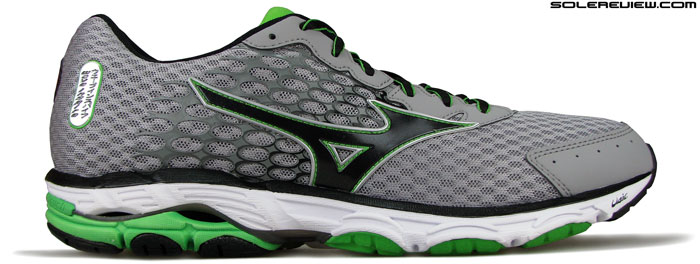

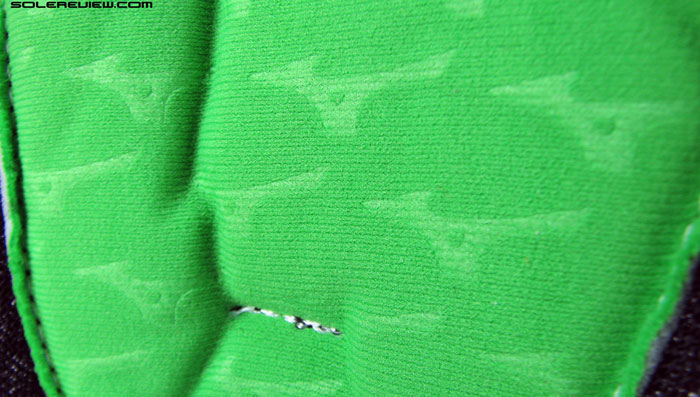
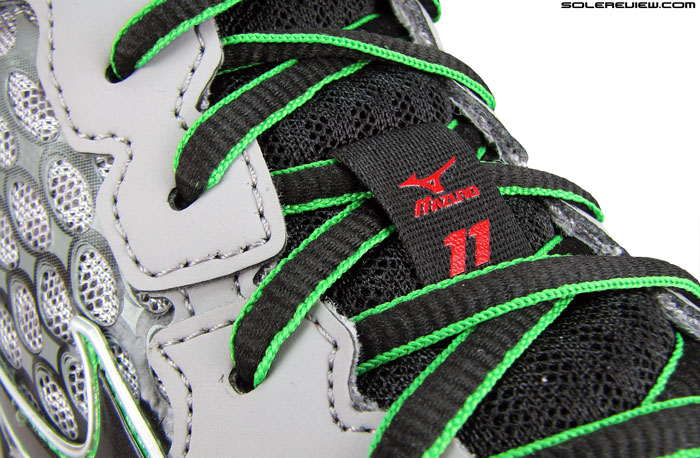




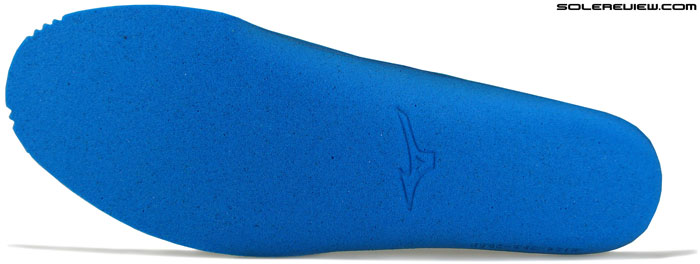


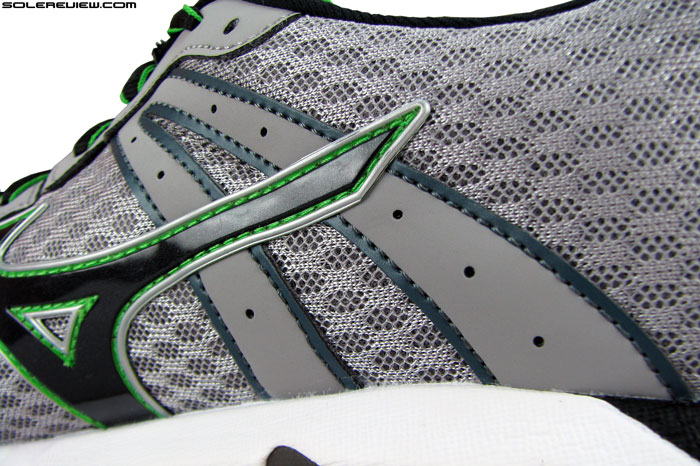

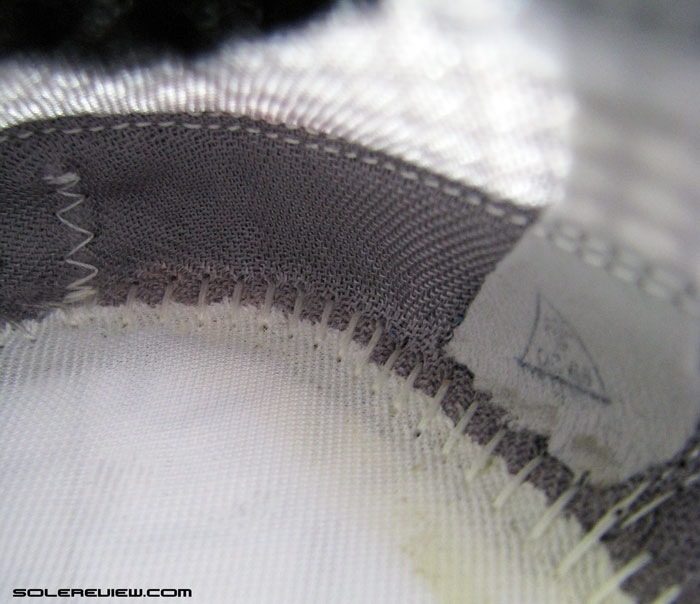


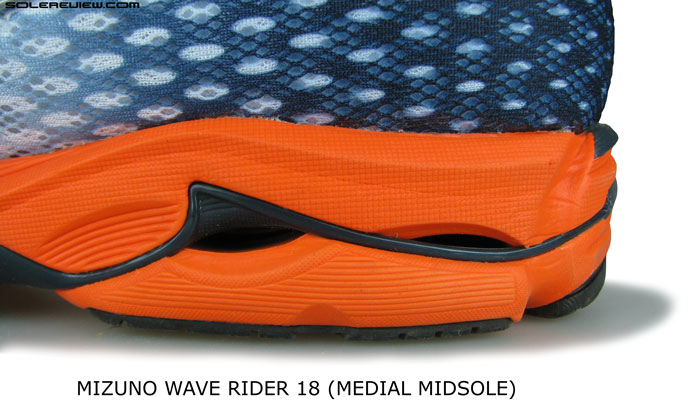
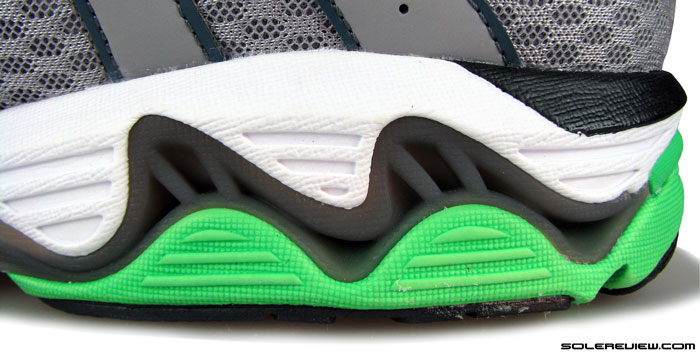
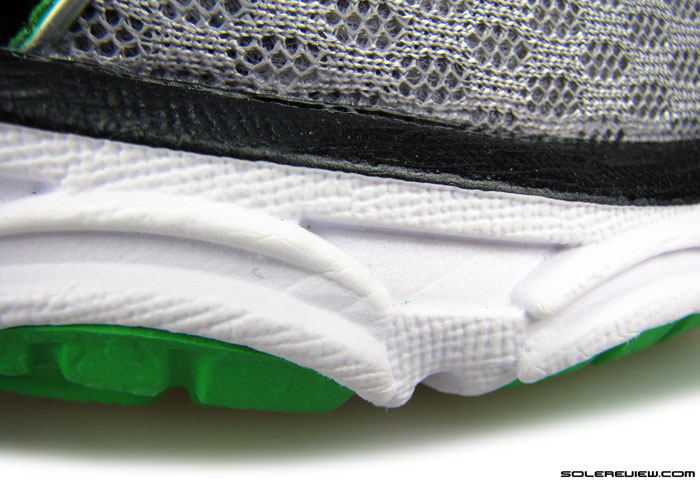



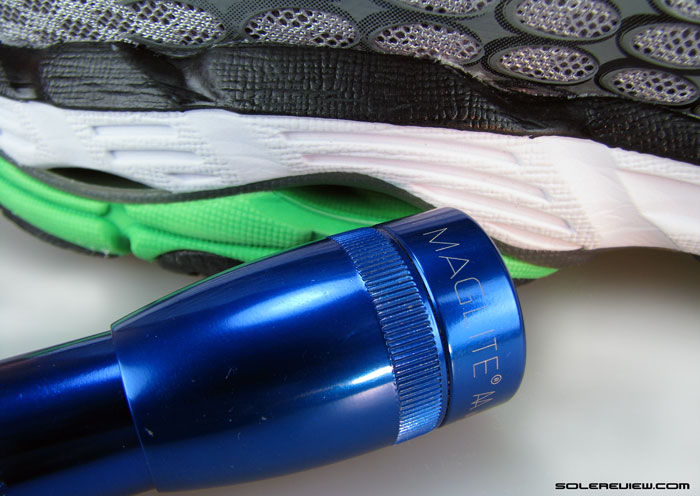
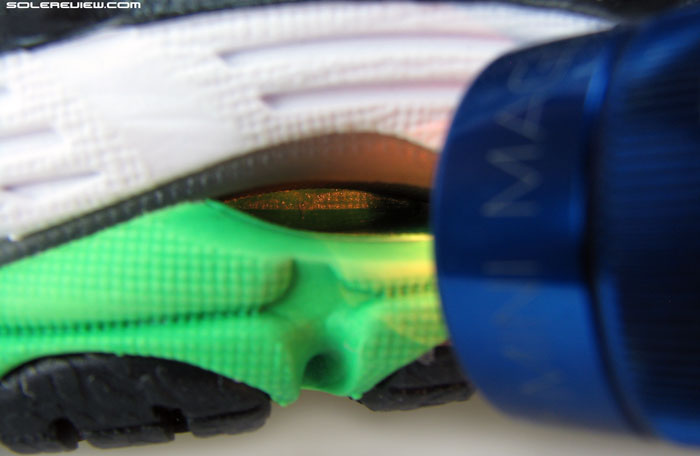


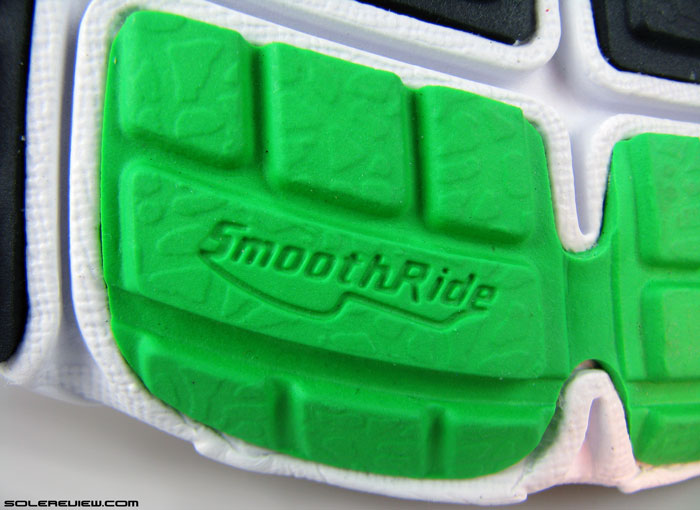


25 comments
The Inspire 10 caused me some awful problems. Without going on too long, I run in neutral shoes with orthotic insoles. I’m a city dweller, and I’ve run on concrete for 38 years. For decades I wore practically nothing but Saucony shoes, until a sales person at my fine local shop suggested Wave Riders. I fell in love with their idiosyncratic ride and wore nothing but the Rider series for the next several years. In fact I became a bit fanatical about Mizuno in general, as the quality of all of their products (apparel as well as shoes) is superb. I even visited their Osaka flagship store. But I’ve tried other models over the years, and none have proved as satisfying as the Rider. When I read reviews of the Inspire 10, all seemed to agree that though they controlled for pronation, the degree of control was minimal. Aside from this characteristic, the shoe’s profile was outstanding – light, fast, flexible, and the usual Mizuno quality and attention to concept. But the pronation control turned out to be rather extreme. So much so that in conjunction with my orthotics, the strain on my left (slightly longer) leg became unbearable. I developed pain in my left knee that I’m still working through. I can’t pretend to have any deep insight into the mechanics of the Inspire 10, but I’ve run in mild pronation-control shoes before (such as Saucony’s Hurricane series), and the control component was largely superfluous. With the Inspire 10 it was truly aggressive. A shame, because the shoe has so much going for it in so many ways, especially for a mid-foot striker. It also troubles me that I can only find one shoe in the Mizuno line that really seems to excel. I’d been committed to maintaining a certain price point with shoes, but purchased the Prophecy 3 when it came out, just to experience firsthand whether such a high-concept shoe could really perform in a way that justified a price double that of their most reliable model. Disappointed; and again, it was not that the shoe didn’t deliver on many, many fronts. It just couldn’t nail that compelling case that would have fully justified it. Mizuno is indeed a perplexing company. So dedicated, it makes you think that if they focused the energy that drives that dedication into solidifying their line using their strongest performer as a foundation, they’d sweep the market. Or could it be that the Rider is just an outlier? Said I wouldn’t go on so long – sorry!
“When I read reviews of the Inspire 10, all seemed to agree that though
they controlled for pronation, the degree of control was minimal.”
I’ve run in the Inspire since version 6 and in my opinion all (maybe except the 7) have had much more than a minimal degree of control. They’re very stable shoes – especially in the rear foot (where I need it). I think the problem is with reviews you had seen rather than the Inspire. As an example, I’ve run in the Hurricane 15 but they were not stable enough for me – went back to Inspires instead – so for me the Inspire was miles more stable.
If you liked the Wave Rider is there a reason why you didn’t continue with that model?
I did, in fact, return to the Rider. You touch on something that did influence me. I wore Hurricanes for years, and was able to clearly gauge the effect of the stability functions. The ride was extremely comfortable at all times, and on days when my ability wasn’t at its peak due to fatigue or other conditions, having the subtle control response the Hurricane offered available was a benefit. The wave plate configuration of the Inspire 10 intrigued me, especially at mid-foot, and I think that the Inspire 10 was said to offer a bit more forefoot cushion and a tad less weight than the concurrent Rider model. I expected the Inspire performance to resemble the Hurricane series, and that the stability functions would be such that I could accommodate them but they wouldn’t be obtrusive, (what you ultimately found lacking about the Hurricanes). It was a roll of the dice that simply didn’t go in my favor. I should be able to walk comfortably in them, though, and they’re an appealingly designed shoe, so there’s that.
Thank you for sharing your experience with the Inspire 10.
Compared to shoes such as the Nike Structure 17, New Balance 860 V5 and Nike Lunarglide 5, our impression of the Inspire 11 was that of a mild pronation control shoe. The shoe’s stable though – but strangely we felt the Rider 18 to be even more so, owing to its firmer (and more neutral leaning) midsole.
Speaking of Mizunos and Japan, have you tried any of their ‘made-in/for-Japan’ models? We did notice some models in running stores around Tokyo, though can’t remember the shoe names.
I did not. At the time I was there I’d just purchased new (Mizuno Wave Riders) in the US. I did see a few trail models that I’d never seen in the US, but wasn’t in the market for those. Mostly I saw colors that I couldn’t find here. I stocked up on other gear though, including a super light competition shirt that I use for everyday running at the height of summer. There’s a lot of unique apparel there.
Agree, Japan makes some of the best textiles. There’s a running jacket lying around, bought from Japan. Of 2001 vintage, and looks fairly new even today, what’s even more amazing, the cuff elastic’s holding up too.
We’d imagine some of the Made in Japan Mizuno racing flats would feature a superior Japanese mesh upper. Will make a mental note to grab a pair or two the next Japan trip for a review.
My wifey and I have always have a pair of Mizuno shoes in our rotation with either Saucony, Brooks (up until they decided to mix the DNAMoGo foam) and Asics. We personally think Mizuno makes some of the best runners with the best fit. My wife has slight overpronation and really bad Plantar Fasciitis with an almost flat feet. She’s been wearing a few incarnations of Inspire (her favourite ones so far is the 6 and the 9) now and has found them to be one of the best shoes in terms of breathability, comfort, as well as being light weight. She’s a heel striker hence find the Inspire’s unique Wave’s shock dispersion property to be very reliable. It’s one of the few shoes she feels no pain whatsoever on her Fascia. Her only niggle with the Inspire is that she wishes there was more forefoot cushioning, hence she’ll rotate to her other pair of runners (at the moment it’s the Kayano 21) for that. She said she’s never had problems with fit (she always wear socks though) apart from women sizing of Mizuno being slightly different from other brands.
Appreciate the detailed feedback!
Hi,
I really like your reviews, very detailed and nice to read, they provide great information for people who know few things about running like me.
However, I would have 2 questions:
1st, between Inspire 11 and Wave Rider 18, for a beginner runner with normal pronation and 70 kgs, which one would you recommend for distances up to marathon? The WR looks nice to me, but if Inspire is quite similar but a bit more comfortable due to more cushioning, then it looks more interesting, i really don’t know how to estimate differences between these 2. Is a “support” shoe actually bad for non-over/underpronator people?
2nd, Even if as i said in the beginning I enjoy your reviews, I’m a bit perplex about your rankings, could you provide some details about how you give a final note? Is the note for 1 shoe given by 1 tester only, or do you make an average of your team members feelings about it?
For example, Inspire 11 and WR18 got 82% and 80% with basically 2 cons: “Inner seam irritates with thin socks or barefoot, lack of reflectivity” (none of them are a pb for me, as i wear socks and got reflections on clothes), but other shoes manage to have higher scores despite what seems to me as bigger pbs: For ex, the Kayano 21 got 85 % despite “Tongue slide, inner lining slightly irritating, price, weight, assembly issues”, and the Speedform Appolo goes up to 90% despite “Poor arch support, shoddy outsole finish, faulty eye-stay design.”
Thanks!
1) We’d choose the Inspire 11 if faced with your predicament – for the same reason you listed. No, a support shoe is not bad for non-neutrals, they work in most cases for a large majority of runners. That said, there will always be cases of subjective disagreement.
2) Our rating methodology has often been questioned, so will be happy to clear the air.
– Ratings are decided by 1 tester for 1 shoe. If a comparison between two past versions (say Wave Prophecy 3 and 4) is involved, it will be the same weartester. This ensures consistency of feedback and better understanding of differences across. This also applies to reviews where two shoes from different categories are compared – like in this case, the Inspire 11 and Rider 18.
– The overall score is calculated using a weighted average of 7 main attributes. These 7 are further broken down into sub-attributes, which again use a weighted addition system. Here are the weights we give to each of the 7 attributes, along with the sub-sets which add up to each of the seven.
* Heel to toe transition (25% weightage): Sub attributes are heel bevel, crash pad articulation, heel to toe drop, midfoot transition, extent of outsole ground contact, flexibility.
* Stability (22% weightage): Ankle eversion, ankle inversion, midfoot stability, forefoot stability, upper fit (yes, this impacts stability)
* Fit (22% weightage): Forefoot space, collar fit, arch support, tongue slide, sockliner contour, midfoot grip
* Material package (7% weightage): Overall construction, ventilation, aesthetic quality, details (reflectivity/cage etc), laces, durability
* Cushioning (7% weightage): Responsiveness, stability, foam compression, insole cushioning, strobel cushioning, efficacy of embedded cushioning system (Gel, Air, Wave, etc)
* Traction ( 12% weightage): Coverage of outsole rubber, lug design, inherent grip of rubber compound used.
* Weight (5% weightage): benchmarked against category medial for that shoe.
So you see, we deem fit, stability, transition and traction to be most important, as these define how structurally sound a particular shoe is. So some of the negatives we mention in our review might end up having very little weightage, and hence will not drag down the score.
Is this rating system perfect? No, but as you can see, there is a well thought of rationale. We also evolve this sheet from time to time, so a like-to-like comparison with a shoe reviewed many months prior might not reflect accurately.
Hope this helps.We’ve attached rating screenshots for the Wave Rider 18, Inspire 11 and Kayano 21 so you get a sense of how the numbers are calculated.
Thanks for the answer and for providing details of your ranking method, this is quite interesting!
You’re welcome. Besides, now we’ve got our work cut out for us. If anyone else asks about ratings the next time, we’ll just redirect them to this detailed comment!
Great review, really like how you
break down each category and I like the overall percentage grade you give the
shoe. The addition of the up close and
detailed pictures are also a plus.
I currently run in the Structure
18 and I am looking to add another one or two pair to my shoe rotation.
I am a bigger runner and I like a
shoe with good forefoot cushioning, I have run in the New Balance 860v4 in the
past and it was ok but forefoot cushion seemed less than desirable for me. With that being said you have covered some of
the shoes that I have been looking to add.
I currently have a pair of New Balance 1260v4 on order.
My question is how do you see the
Inspire 11, Asics GT 2000 3 and New Balance 860v5 stacking up to the Structure
18 in forefoot cushioning and stability.
To me the Structure seems to have good forefoot cushioning, so far I am pleased with it however with the pillar the Structure has at times it seems a
bit ridged or hard, I am willing to cut back a little on the support/structure
of a shoe for the cushioning.
I do have a pair of Wave Rider 18’s
and agree with your review that forefoot cushioning is lacking, I had the
previous 16’s and liked those a lot. The
18’s have lost favor with me. (I do know this is a neutral shoe)
Also I do have a wide foot,
currently in a 4E with the Structure 18 and a 2E with the New Balance 1260v4.
Thanks
We’ll first like to break down your question by cushioning and support/structure:
– Forefoot cushioning in order of high to low: NB 1260 V4, GT-2000 3, Structure 18/860 V5 (levels are similar, except Nike has more firmness yet balanced with responsiveness), Inspire 11.
– Support/Structure from high to low: Structure 18, Inspire 11, 1260 V4, GT 2000 3, 860 V5.
If you look at what’ve laid out here, the 1260V4 sits in the sweet spot of cushioning and support. Since you already have the 1260 V4 on order, why not try it first and then take a call whether you need another pair?
Where’s the Adrenaline GTS 15 review! We’ve been waiting for what feels like forever, this shoe has been available for over 2 months now.
Ps. Love your reviews
I own a pair of Mizuno wave inspire 11. I having been buying the wave inspire model since wave inspire 6 and I think this model is the first step backwards I have seen. The sizing has changed they are too narrow. They are hotter on your feet. I will be throwing mine in the bin after two runs. If the shop has wave inspire 10 buy them instead. Very disappointed in the new version.
We haven’t tested the Inspire 10, so thank you for the feedback, it helps.
I have been a huge Inspire advocate since the 8’s. When it comes to pronation, I have flat feet, but am a good midfoot striker, so I can where either an adrenaline, trance, guide, triax, or paradox. In fact, I’ve tried all of those (college runner perks). The Inspire 9’s are my all time favorite shoe. They combined the responsiveness of a newton with the stability of an adrenaline, in my opinion. Plus, they were light weight and could still get 400ish miles on them. The Inspire 10’s absolutely dropped the ball. They were stiff and cardboard like, and I tend to prefer a firmer feeling shoes. When I ran in the 11’s, I was ecstatic. The 9’s are still better (last longer, more responsive), but the 11’s are still fantastic. They provide enough support, so I’d say they are a decently high stablity shoe. One thing that sucks: the upper. I’ve noticed that a lot of shoe companies are going to 3D uppers in order to achieve a more forming, lighter shoe. While this is true, it makes the durability drop dramatically. At around 300 miles, I bust out of the side (kind of like the problem with the Kinvara 3’s). That’s another downfall: the durability of this shoe is at least 100 miles smaller than something like the adrenaline.
I’m a huge Mizuno advocate, but their inconsistencies from model to model frustrate me. They always modify something that was already perfect! I’ve heard they’re bringing back the elixir, though. Look at brooks: they hardly every change the adrenaline, because there isn’t anything wrong with it (I’m still pissed they took away the Trance, though. The Trascend was a total flop!).
Thank you for the detailed feedback, very useful for us as background knowledge.
All the brands change – speaking of Adrenaline, have you tried the GTS 15? Very different from GTS 14, that’s for sure.
I agree: the 9’s rocked, the 10’s….not so much. I talked to a Mizuno shoe rep, and we seem to be in the norm, which is why Mizuno made the 11’s feel more like the 9’s. I still wish they would add a little bit more to the midsole like the 9’s in order to get more miles out of them. Yes, that would add weight, but a little bit more is worth it if the shoe lasts me 100 more miles or so. When going through shoes as fast as I do, this is important!
Thanks for the feedback, great background knowledge for us to have – since we haven’t tested any prior versions of the Inspire.
I ran in these for the first time this morning and I posted a PB for my 5km time. Overall I feel really happy with the fit of the shoe and the level of stability it gave me. These are firm shoes when compared to things like Kayanos but the firmness seems to melt away at pace and while it is still there you don’t notice that they are a bit firm. I would say these are in the goldilocks zone for ride. I picked these up when returning my ultra boost due to rapid wear and the need for some stability and I tried on Asics Kayano, gt1000, gt 2000, foundation, Brooks Adrenaline gts 15, new balance 860 and Mizuno creation and paradox. I thought the sales guy was about ready to kick me out of the store by the time I had finished trying on everything! The closest to this by far was the Mizuno paradox but I felt that while it was more comfortable it was less stable. Thanks for the review!
Mizuno does have a very unique ride, so it is hard to find people with a divided opinion on them. Runners either like them, or simply don’t.
We also like how the cushioning behavior run more or less consistent across models. Don’t see that in most brands.
I have previously had wave inspire 7 and 10, both of which I really loved.
The Inspire 11 seems to come up higher and stiffer around the ankle than these previous models, which is causing me a lot of grief. It only became apparent as a problem after a couple of wears and about 50kms in the shoes. Goes to show you just can’t tell! Most people seem to hate model 10 and love 11 but not everyone!
Appreciate the feedback, no had idea how the Inspire 10 fit!
Comments are closed.